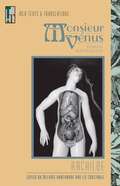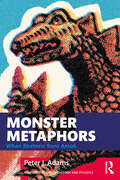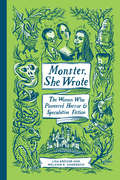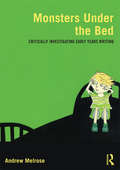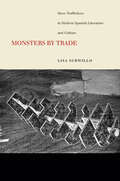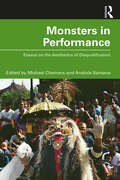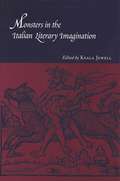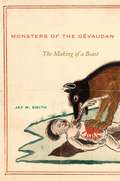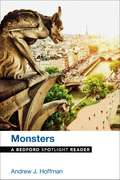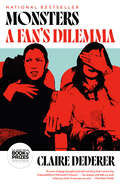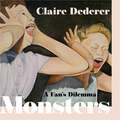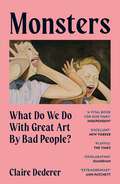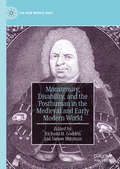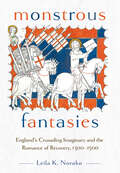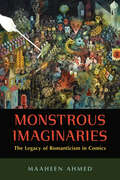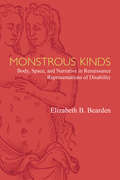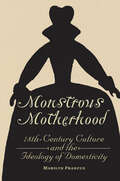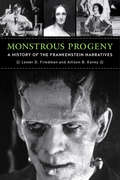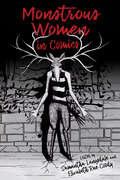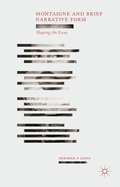- Table View
- List View
Monsieur Vénus: Roman matérialiste (Texts and Translations #15)
by RachildeWhen the rich and well-connected Raoule de Vénérande becomes enamored of Jacques Silvert, a poor young man who makes artificial flowers for a living, she turns him into her mistress and eventually into her wife. Raoule's suitor, a cigar-smoking former hussar officer, becomes an accomplice in the complications that ensue.
Monster Metaphors: When Rhetoric Runs Amok (Routledge Studies in Rhetoric and Stylistics)
by Peter J. AdamsThis book explores ways in which common metaphors can play a detrimental role in everyday life; how they can grow in outsized importance to dominate their respective terrains and push out alternative perspectives; and how forms of resistance might act to contain their dominance. The volume begins by unpacking the dynamics of metaphors, their power and influence and the ways in which they are bolstered by other rhetorical devices. Adams draws on four case studies to illustrate their destructive impact when they eclipse other points of view—the metaphor of mental illness; the metaphor of free-flowing markets; the metaphor of the mind as a mirror and the metaphor of men as naturally superior. Taken together, these examples prompt further reflection on the beneficiaries of these "monster metaphors" and how they promote such metaphors to serve their own interests but also on ways forward for challenging their dominance, strategies for preventing their rise and ways of creating space for alternatives. This book will be of interest to scholars interested in the study of metaphor, across such fields as linguistics, rhetoric and media studies.
Monster Theory: Reading Culture
by Jeffrey Jerome CohenWe live in a time of monsters. Monsters provide a key to understanding the culture that spawned them. So argue the essays in this wide-ranging and fascinating collection that asks the question, What happens when critical theorists take the study of monsters seriously as a means of examining our culture? In viewing the monstrous body as a metaphor for the cultural body, the contributors to Monster Theory consider beasts, demons, freaks, and fiends as symbolic expressions of cultural unease that pervade a society and shape its collective behavior. Through a historical sampling of monsters, these essays argue that our fascination for the monstrous testifies to our continued desire to explore difference and prohibition.Contributors: Mary Baine Campbell, Brandeis U; David L. Clark, McMaster U; Frank Grady, U of Missouri, St. Louis; David A. Hedrich Hirsch, U of Illinois; Lawrence D. Kritzman, Dartmouth College; Kathleen Perry Long, Cornell U; Stephen Pender; Allison Pingree, Harvard U; Anne Lake Prescott, Barnard College; John O'Neill, York U; William Sayers, George Washington U; Michael Uebel, U of Virginia; Ruth Waterhouse.
Monster and the Magic Umbrella
by Ann Mariah Cook Ellen BlanceWhat will Monster do with his magic umbrella?
Monster, She Wrote: The Women Who Pioneered Horror and Speculative Fiction
by Melanie R. Anderson Lisa KrögerMeet the women writers who defied convention to craft some of literature’s strangest tales, from Frankenstein to The Haunting of Hill House and beyond. Frankenstein was just the beginning: horror stories and other weird fiction wouldn’t exist without the women who created it. From Gothic ghost stories to psychological horror to science fiction, women have been primary architects of speculative literature of all sorts. And their own life stories are as intriguing as their fiction. Everyone knows about Mary Shelley, creator of Frankenstein, who was rumored to keep her late husband’s heart in her desk drawer. But have you heard of Margaret “Mad Madge” Cavendish, who wrote a science-fiction epic 150 years earlier (and liked to wear topless gowns to the theater)? If you know the astounding work of Shirley Jackson, whose novel The Haunting of Hill House was reinvented as a Netflix series, then try the psychological hauntings of Violet Paget, who was openly involved in long-term romantic relationships with women in the Victorian era. You’ll meet celebrated icons (Ann Radcliffe, V. C. Andrews), forgotten wordsmiths (Eli Colter, Ruby Jean Jensen), and today’s vanguard (Helen Oyeyemi). Curated reading lists point you to their most spine-chilling tales.Part biography, part reader’s guide, the engaging write-ups and detailed reading lists will introduce you to more than a hundred authors and over two hundred of their mysterious and spooky novels, novellas, and stories.
Monsters
by L. Andrew Cooper Brandy Ball BlakeThe Fountainhead Press V Series is a new collection of single-topic readers that take a unique look at some of today's most pressing issues. Designed to give writing students a more nuanced introduction to public discourse--on the environment, on food, and on digital life, to name a few of the topics--the books feature writing, research, and invention prompts that can be adapted to nearly any kind of college writing class.
Monsters Under the Bed: Critically investigating early years writing
by Andrew MelroseMonsters Under the Bed is an essential text focussing on critical and contemporary issues surrounding writing for ‘early years’ children. Containing a critically creative and a creatively critical investigation of the cult and culture of the child and childhood in fiction and non-fictional writing, it also contains a wealth of ideas and critical advice. This text dynamically explores the issue of picture books, literacy and writing for early years children with a wider view on child-centred culture, communication and media. Internationally recognised as an expert in the field, Andrew Melrose encourages academics, researchers and students to examine the fundamental questions in writing for and addressing ‘early years’ children, through an exploration of text and images. Accessibly written and lively in its approach, this book includes: an accessible and critically important challenge to the latest international academic research and debates in the field of children’s literature and creative writing an extensive investigation of early years writing and reading a pathway to developing critical awareness of children’s literature, allowing students to develop their own critical ability and writing skills constant ‘checkpoints’ throughout, in which the reader is encouraged to reflect on critically creative and creatively critical development. Providing a coherent and pedagogical approach, this compelling text will be an indispensable resource for critics, writers and students interested in children's writing, as well as those on Creative Writing, Children's Literature and English BA and MA programmes. It will also be of great interest to those in teacher training, PGCE students and for those studying at Doctoral and Post-Doctoral level.
Monsters by Trade: Slave Traffickers in Modern Spanish Literature and Culture
by Lisa SurwilloTransatlantic studies have begun to explore the lasting influence of Spain on its former colonies and the surviving ties between the American nations and Spain. In Monsters by Trade, Lisa Surwillo takes a different approach, explaining how modern Spain was literally made by its Cuban colony. Long after the transatlantic slave trade had been abolished, Spain continued to smuggle thousands of Africans annually to Cuba to work the sugar plantations. Nearly a third of the royal income came from Cuban sugar, and these profits underwrote Spain's modernization even as they damaged its international standing. Surwillo analyzes a sampling of nineteenth-century Spanish literary works that reflected metropolitan fears of the hold that slave traders (and the slave economy more generally) had over the political, cultural, and financial networks of power. She also examines how the nineteenth-century empire and the role of the slave trader are commemorated in contemporary tourism and literature in various regions in Northern Spain. This is the first book to demonstrate the centrality of not just Cuba, but the illicit transatlantic slave trade to the cultural life of modern Spain.
Monsters by Trade: Slave Traffickers in Modern Spanish Literature and Culture
by Lisa SurwilloTransatlantic studies have begun to explore the lasting influence of Spain on its former colonies and the surviving ties between the American nations and Spain. In Monsters by Trade, Lisa Surwillo takes a different approach, explaining how modern Spain was literally made by its Cuban colony. Long after the transatlantic slave trade had been abolished, Spain continued to smuggle thousands of Africans annually to Cuba to work the sugar plantations. Nearly a third of the royal income came from Cuban sugar, and these profits underwrote Spain's modernization even as they damaged its international standing. Surwillo analyzes a sampling of nineteenth-century Spanish literary works that reflected metropolitan fears of the hold that slave traders (and the slave economy more generally) had over the political, cultural, and financial networks of power. She also examines how the nineteenth-century empire and the role of the slave trader are commemorated in contemporary tourism and literature in various regions in Northern Spain. This is the first book to demonstrate the centrality of not just Cuba, but the illicit transatlantic slave trade to the cultural life of modern Spain.
Monsters in Performance: Essays on the Aesthetics of Disqualification
by Analola Santana Michael ChemersMonsters in Performance boasts an impressive range of contemporary essays that delve into topical themes such as race, gender, and disability, to explore what constitutes monstrosity within the performing arts. These fascinating essays from leading and emerging scholars explore representation in performance, specifically concerning themselves with attempts at social disqualification of "undesirables." Throughout, the writers employ the concept of "monstrosity" to describe the cultural processes by which certain identities or bodies are configured to be threateningly deviant. The editors take a range of previously isolated critical inquiries – including bioethics, critical race studies, queer studies, and televisual studies - and merge them to create an accessible and dynamic platform which unifies these ranges of representations. The global scope and interdisciplinary nature of Monsters in Performance renders it an essential book for Theatre and Performance students of all levels as well as scholars; it will also be an enlightening text for those interested in monstrosity and Cultural Studies more broadly.
Monsters in the Italian Literary Imagination
by Keala JewellA culture defines monsters against what is essentially thought of as human. Creatures such as the harpy, the siren, the witch, and the half-human all threaten to destroy our sense of power and intelligence and usurp our human consciousness. In this way, monster myths actually work to define a culture's definition of what is human. In Monsters in the Italian Literary Imagination, a broad range of scholars examine the monster in Italian culture and its evolution from the medieval period to the twentieth century. Editor Keala Jewell explores how Italian culture juxtaposes the powers of the monster against the human. The essays in this volume engage a wide variety of philological, feminist, and psychoanalytical approaches and examine monstrous figures from the medieval to postmodern periods. They each share a critical interest in how monsters reflect a culture's dominant ideologies.
Monsters of the Gévaudan: The Making of a Beast
by Jay M. SmithIn a brilliant, original rendition, Monsters of the Gévaudan revisits a spellbinding French tale that has captivated imaginations for over two hundred years, and offers the definitive explanation of the strange events that underlie this timeless story. In 1764 a peasant girl was killed and partially eaten while tending a flock of sheep. Eventually, over a hundred victims fell prey to a mysterious creature, or creatures, whose cunning and deadly efficiency terrorized the region and mesmerized Europe. The fearsome aggressor quickly took on mythic status, and the beast of the Gévaudan passed into French folklore. What species was this killer, why did it decapitate so many of its victims, and why did it prefer the flesh of women and children? Why did contemporaries assume that the beast was anything but a wolf, or a pack of wolves, as authorities eventually claimed, and why is the tale so often ignored in histories of the ancien régime? Smith finds the answer to these last two questions in an accident of timing. The beast was bound to be perceived as strange and anomalous because its ravages coincided with the emergence of modernity itself. Expertly situated within the social, intellectual, cultural, and political currents of French life in the 1760s, Monsters of the Gévaudan will engage a wide range of readers with both its recasting of the beast narrative and its compelling insights into the allure of the monstrous in historical memory.
Monsters: A Bedford Spotlight Reader
by Andrew J. HoffmanMonsters seem to be everywhere, and it's easy to see why: they're fun. Young and old pile into movie theaters to watch the latest releases from Hollywood featuring both the scary and the attractive–carnivorous zombies, love-struck vampires, bloodthirsty werewolves, even methodical serial killers.
Monsters: A Fan's Dilemma
by Claire DedererA NEW YORK TIMES NOTABLE BOOK • NATIONAL BESTSELLER • A timely, passionate, provocative, blisteringly smart interrogation of how we make and experience art in the age of cancel culture, and of the link between genius and monstrosity. Can we love the work of controversial classic and contemporary artists but dislike the artist?"A lively, personal exploration of how one might think about the art of those who do bad things" —Vanity Fair • "[Dederer] breaks new ground, making a complex cultural conversation feel brand new." —Ada Calhoun, author of Also a Poet From the author of the New York Times best seller Poser and the acclaimed memoir Love and Trouble, Monsters is &“part memoir, part treatise, and all treat&” (The New York Times). This unflinching, deeply personal book expands on Claire Dederer&’s instantly viral Paris Review essay, "What Do We Do with the Art of Monstrous Men?" Can we love the work of artists such as Hemingway, Sylvia Plath, Miles Davis, Polanski, or Picasso? Should we? Dederer explores the audience's relationship with artists from Michael Jackson to Virginia Woolf, asking: How do we balance our undeniable sense of moral outrage with our equally undeniable love of the work? Is male monstrosity the same as female monstrosity? And if an artist is also a mother, does one identity inexorably, and fatally, interrupt the other? In a more troubling vein, she wonders if an artist needs to be a monster in order to create something great. Does genius deserve special dispensation? Does art have a mandate to depict the darker elements of the psyche? And what happens if the artist stares too long into the abyss? Highly topical, morally wise, honest to the core, Monsters is certain to incite a conversation about whether and how we can separate artists from their art.&“Monsters leaves us with Dederer&’s passionate commitment to the artists whose work most matters to her, and a framework to address these questions about the artists who matter most to us." —The Washington PostA Best Book of the Year: The New York Times, NPR, The Washington Post, The New Yorker, Vulture, Elle, Esquire, Kirkus
Monsters: A Fan’s Dilemma
by Claire DedererA passionate, provocative and blisteringly smart interrogation of how we experience art in the age of #MeToo, and whether we can separate an artist's work from their biography.What do we do with the art of monstrous men? Can we love the work of Roman Polanski and Michael Jackson, Hemingway and Picasso? Should we love it? Does genius deserve special dispensation? Is history an excuse? What makes women artists monstrous? And what should we do with beauty, and with our unruly feelings about it?Claire Dederer explores these questions and our relationships with the artists whose behaviour disrupts our ability to apprehend the work on its own terms. She interrogates her own responses and her own behaviour, and she pushes the fan, and the listener, to do the same. Morally wise, deeply considered and sharply written, Monsters gets to the heart of one of our most pressing conversations.(P) 2023 Penguin Audio
Monsters: A Fan’s Dilemma
by Claire Dederer'An exhilarating, shape-shifting exploration of the perilous boundaries between art and life' JENNY OFFILL'An incredible book, the best work of criticism I have read in a very long time' NICK HORNBY'Wise and bold and full of the kind of gravitas that might even rub off' LISA TADDEOA passionate, provocative and blisteringly smart interrogation of how we experience art in the age of #MeToo, and whether we can separate an artist's work from their biography.What do we do with the art of monstrous men? Can we love the work of Roman Polanski and Michael Jackson, Hemingway and Picasso? Should we love it? Does genius deserve special dispensation? What makes women artists monstrous? And what should we do with beauty, and with our unruly feelings about it?Claire Dederer explores these questions and our relationships with the artists whose behaviour disrupts our ability to understand the work on its own terms. She interrogates her own responses and behaviour, and she pushes the fan, and the reader, to do the same. Morally wise, deeply considered and sharply written, Monsters gets to the heart of one of our most pressing conversations.'A blisteringly erudite and entertaining read . . . It's a book that deserves to be widely read and will provoke many conversations' NATHAN FILER'Fascinating . . . Dederer poses so many topical questions, plays with so many pertinent ideas, that I'm still thinking about this book long after I finished it' CLAIRE FULLER
Monstrosity, Disability, and the Posthuman in the Medieval and Early Modern World (The New Middle Ages)
by Richard H. Godden Asa Simon MittmanThis collection examines the intersection of the discourses of “disability” and “monstrosity” in a timely and necessary intervention in the scholarly fields of Disability Studies and Monster Studies. Analyzing Medieval and Early Modern art and literature replete with images of non-normative bodies, these essays consider the pernicious history of defining people with distinctly non-normative bodies or non-normative cognition as monsters. In many cases throughout Western history, a figure marked by what Rosemarie Garland-Thomson has termed “the extraordinary body” is labeled a “monster.” This volume explores the origins of this conflation, examines the problems and possibilities inherent in it, and casts both disability and monstrosity in light of emergent, empowering discourses of posthumanism.
Monstrous Fantasies: England's Crusading Imaginary and the Romance of Recovery, 1300-1500
by Leila K. NorakoMonstrous Fantasies asks why medieval romances reimagining the crusades ending in a Christian victory circulated in England with such abundance after the 1291 Muslim reconquest of Acre, the last of the Latin crusader states in the Holy Land, and what these texts reveal about the cultural anxieties of late medieval England. Leila K. Norako highlights the impact that the Ottoman victory and subsequent massacre of Christian prisoners at the battle of Nicopolis in 1396 had on intensifying the popularity of what she calls recovery romance. These two episodes inspired a sense of urgency over the fate of the Holy Land and of Latin Christendom itself, resulting in the proliferation of romances in which crusading English kings like Richard I and anachronistic legends like King Arthur not only reconquered Jerusalem but committed genocidal violence against the Muslims. These romances, which—as Norako argues—also influenced Geoffrey Chaucer's Canterbury Tales, conjure fantasies of an ascendant global Christendom by rehearsing acts of conquest and cultural annihilation that were impossible to realize in the late Middle Ages. Emphasizing the tension in these texts between nostalgia and anticipation that fuels their narrative momentum, Monstrous Fantasies also explores how the cultural desires for European and Christian hegemony that recovery romances versified were revived in the wake of the so-called wars on terror in the twenty-first century in such films as Kingdom of Heaven and American Sniper.
Monstrous Imaginaries: The Legacy of Romanticism in Comics
by Maaheen AhmedMonsters seem inevitably linked to humans and not always as mere opposites. Maaheen Ahmed examines good monsters in comics to show how Romantic themes from the eighteenth and the nineteenth centuries persist in today’s popular culture. Comics monsters, questioning the distinction between human and monster, self and other, are valuable conduits of Romantic inclinations. Engaging with Romanticism and the many monsters created by Romantic writers and artists such as Mary Shelley, Victor Hugo, and Goya, Ahmed maps the heritage, functions, and effects of monsters in contemporary comics and graphic novels. She highlights the persistence of recurrent Romantic features through monstrous protagonists in English- and French-language comics and draws out their implications. Aspects covered include the dark Romantic predilection for ruins and the sordid, the solitary protagonist and his quest, nostalgia, the prominence of the spectacle as well as excessive emotions, and above all, the monster’s ambiguity and rebelliousness. Ahmed highlights each Romantic theme through close readings of well-known but often overlooked comics, including Enki Bilal's Monstre tetralogy, Jim O'Barr's The Crow, and Emil Ferris’s My Favorite Thing Is Monsters, as well as the iconic comics series Alan Moore's Swamp Thing and Mike Mignola's Hellboy. In blurring the otherness of the monster, these protagonists retain the exaggeration and uncontrollability of all monsters while incorporating Romantic characteristics.
Monstrous Kinds: Body, Space, and Narrative in Renaissance Representations of Disability (Corporealities: Discourses Of Disability)
by Elizabeth BeardenMonstrous Kinds is the first book to explore textual representations of disability in the global Renaissance. Elizabeth B. Bearden contends that monstrosity, as a precursor to modern concepts of disability, has much to teach about our tendency to inscribe disability with meaning. Understanding how early modern writers approached disability not only provides more accurate genealogies of disability, but also helps nuance current aesthetic and theoretical disability formulations. The book analyzes the cultural valences of early modern disability across a broad national and chronological span, attending to the specific bodily, spatial, and aesthetic systems that contributed to early modern literary representations of disability. The cross section of texts (including conduct books and treatises, travel writing and wonder books) is comparative, putting canonical European authors such as Castiglione into dialogue with transatlantic and Anglo-Ottoman literary exchange. Bearden questions grand narratives that convey a progression of disability from supernatural marvel to medical specimen, suggesting that, instead, these categories coexist and intersect.
Monstrous Motherhood: Eighteenth-Century Culture and the Ideology of Domesticity
by Marilyn FrancusSpectral and monstrous mothers populate the cultural and literary landscape of the eighteenth century, overturning scholarly assumptions about this being an era of ideal motherhood.Although credited with the rise of domesticity, eighteenth-century British culture singularly lacked narratives of good mothers, ostensibly the most domestic of females. With startling frequency, the best mother was absent, disembodied, voiceless, or dead. British culture told tales almost exclusively of wicked, surrogate, or spectral mothers—revealing the defects of domestic ideology, the cultural fascination with standards and deviance, and the desire to police maternal behaviors. Monstrous Motherhood analyzes eighteenth-century motherhood in light of the inconsistencies among domestic ideology, narrative, and historical practice. If domesticity was so important, why is the good mother’s story absent or peripheral? What do the available maternal narratives suggest about domestic ideology and the expectations and enactment of motherhood? By focusing on literary and historical mothers in novels, plays, poems, diaries, conduct manuals, contemporary court cases, realist fiction, fairy tales, satire, and romance, Marilyn Francus reclaims silenced maternal voices and perspectives. She exposes the mechanisms of maternal marginalization and spectralization in eighteenth-century culture and revises the domesticity thesis.Monstrous Motherhood will compel scholars in eighteenth-century studies, women’s studies, family history, and cultural studies to reevaluate a foundational assumption that has driven much of the discourse in their fields.
Monstrous Progeny: A History of the Frankenstein Narratives
by Lester D. Friedman Allison B. KaveyMary Shelley's 1818 novel Frankenstein is its own type of monster mythos that will not die, a corpus whose parts keep getting harvested to animate new artistic creations. What makes this tale so adaptable and so resilient that, nearly 200 years later, it remains vitally relevant in a culture radically different from the one that spawned its birth? Monstrous Progeny takes readers on a fascinating exploration of the Frankenstein family tree, tracing the literary and intellectual roots of Shelley's novel from the sixteenth century and analyzing the evolution of the book's figures and themes into modern productions that range from children's cartoons to pornography. Along the way, media scholar Lester D. Friedman and historian Allison B. Kavey examine the adaptation and evolution of Victor Frankenstein and his monster across different genres and in different eras. In doing so, they demonstrate how Shelley's tale and its characters continue to provide crucial reference points for current debates about bioethics, artificial intelligence, cyborg lifeforms, and the limits of scientific progress. Blending an extensive historical overview with a detailed analysis of key texts, the authors reveal how the Frankenstein legacy arose from a series of fluid intellectual contexts and continues to pulsate through an extraordinary body of media products. Both thought-provoking and entertaining, Monstrous Progeny offers a lively look at an undying and significant cultural phenomenon.
Monstrous Women in Comics (Horror and Monstrosity Studies Series)
by Samantha Langsdale and Elizabeth Rae CoodyContributions by Novia Shih-Shan Chen, Elizabeth Rae Coody, Keri Crist-Wagner, Sara Durazo-DeMoss, Charlotte Johanne Fabricius, Ayanni C. Hanna, Christina M. Knopf, Tomoko Kuribayashi, Samantha Langsdale, Jeannie Ludlow, Marcela Murillo, Sho Ogawa, Pauline J. Reynolds, Stefanie Snider, J. Richard Stevens, Justin Wigard, Daniel F. Yezbick, and Jing Zhang Monsters seem to be everywhere these days, in popular shows on television, in award-winning novels, and again and again in Hollywood blockbusters. They are figures that lurk in the margins and so, by contrast, help to illuminate the center—the embodiment of abnormality that summons the definition of normalcy by virtue of everything they are not. Samantha Langsdale and Elizabeth Rae Coody’s edited volume explores the coding of woman as monstrous and how the monster as dangerously evocative of women/femininity/the female is exacerbated by the intersection of gender with sexuality, race, nationality, and disability. To analyze monstrous women is not only to examine comics, but also to witness how those constructions correspond to women’s real material experiences. Each section takes a critical look at the cultural context surrounding varied monstrous voices: embodiment, maternity, childhood, power, and performance. Featured are essays on such comics as Faith, Monstress, Bitch Planet, and Batgirl and such characters as Harley Quinn and Wonder Woman. This volume probes into the patriarchal contexts wherein men are assumed to be representative of the normative, universal subject, such that women frequently become monsters.
Monstrous Work and Radical Satisfaction: Black Women Writing under Segregation
by Eve DunbarRadical Black feminist refusal through the works of mid-twentieth-century African American women writers Monstrous Work and Radical Satisfaction offers new and insightful readings of African American women&’s writings in the 1930s–1950s, illustrating how these writers centered Black women&’s satisfaction as radical resistance to the false and incomplete promise of liberal racial integration. Eve Dunbar examines the writings of Ann Petry, Dorothy West, Alice Childress, and Gwendolyn Brooks to show how these women explored self-fulfillment over normative and sanctioned models of national belonging. Paying close attention to literary moments of disruption, miscommunication, or confusion rather than ease, assimilation, or mutual understanding around race and gender, Dunbar tracks these writers&’ dissatisfaction with American race relations. She shows how Petry, West, Childress, and Brooks redeploy the idea of monstrous work to offer potential modalities for registering Black women&’s capacity to locate satisfaction within the domestic and interpersonal. While racial integration may satisfy the national idea of equality and inclusion, it has not met the long-term needs of Black people&’s quest for equity. Dunbar responds, demonstrating how these mid-century women offer new blueprints for Black life by creating narrative models for radical satisfaction: Black women&’s completeness, joy, and happiness outside the bounds of normative racial inclusion.
Montaigne and Brief Narrative Form
by Deborah N. LosseThe first book-length study to trace the origins of the essay to the conte, Montaigne and Brief Narrative Form puts the reader in touch with how unstable times and exceptional artistic insights transform one genre to create a new artistic form.
